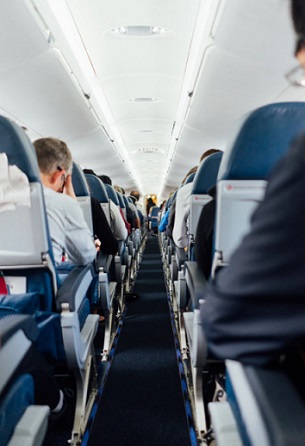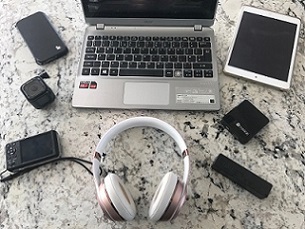 A fire is the last thing you want to happen in the confined space of a passenger plane
A fire is the last thing you want to happen in the confined space of a passenger plane
 All these gadgets powered by lithium-ion batteries are regularly taken on board aircraft by passengers
All these gadgets powered by lithium-ion batteries are regularly taken on board aircraft by passengers
 A pilot with an AvSax battery fire containment bag
A pilot with an AvSax battery fire containment bag
A fire on a passenger plane has thrown the media spotlight on the need for battery fire containment bags on all passenger aircraft.
Passengers were evacuated from an Alaska Airlines flight after a passenger’s mobile phone caught fire as it touched down in Seattle, Washington, after arriving from New Orleans.
The fire had filled the inside of the plane with smoke and media across the world reported that the phone had been placed in a battery containment bag to extinguish the fire.
The 128 passengers and six crew evacuated safely from the plane.
But what are battery fire containment bags and why are they so important?
Almost all personal electronic devices (PEDs) ranging from mobile phones to laptops are powered by lithium-ion batteries – but they have been known to overheat and catch fire and if that happens in the confined space of an aircraft passenger cabin it can cause a potentially catastrophic problem.
In the USA alone, the Federal Aviation Administration reports that up to June 30, 2021, there have been 322 thermal incidents involving lithium batteries as air cargo or baggage recorded since January 23, 2006. Many of the batteries were in personal electronic devices (PEDS) such as headphones, mobile phones, laptops and even e-cigarettes.
Once lithium batteries overheat they can quickly go into what’s known as thermal runaway, a rapid, uncontrolled chemical reaction within the battery that causes the internal temperature to rise.
When one cell in a battery overheats it can produce enough heat - up to 900°C (1652°F) - to make adjacent cells overheat too. This can cause a lithium battery fire to flare repeatedly which is why many airlines use smoke mitigation bags that use liquid inside them to keep the overheating battery cool.
Battery fire containment bags – also known as burn bags – are made from a special fire-resistant material and the world’s best-selling one, AvSax, is designed so water can also be poured in it to cool the overheating or burning device down and stop it from flaring up again.
AvSax are the world’s best-selling fire containment bag for personal electronic devices (PEDs) on aircraft and are now on more than 15,373 aircraft operated by 80 airline companies. They have been used 33 times to deal with emergencies since the start of 2017 and every time they have been deployed the aircraft has been able to complete its journey safely with no need to divert or make an emergency landing.
AvSax won the prestigious Queen’s Award for Enterprise in the UK in 2018.
A report by Airbus called Lithium batteries, safe to fly? has warned about the dangers of fires on board planes caused by lithium-ion batteries.
It states: “Hundreds of millions of lithium batteries or equipment with lithium batteries are carried on aircraft annually.
“But the introduction of lithium batteries included some highly visible cases of mobile phones or laptops self-igniting and burning. Likewise, several events have occurred on aircraft, ranging from localised and limited fires to large, uncontrolled in-flight fires resulting in hull losses and fatalities.”
The Airbus report states: “Classical firefighting procedures and fire extinguishing are not efficient to stop a lithium battery fire.
“Halon can suppress open flames but it’s ineffective in addressing the source of fire. Use of water is the best option to allow cooling and limit the propagation to adjacent cells.
“Once a lithium battery cell has ignited then the effort must concentrate on cooling the surrounding cells by use of water (or other non-alcoholic liquid) and preventing deterioration of the situation to avoid any fire propagation to the adjacent battery cells.”
AvSax battery fire mitigation bags – unlike other burn bags - do have this vital cooling aspect built into the effective way they work to contain overheating lithium-ion batteries.